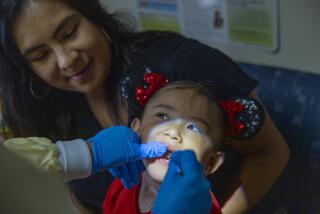Dentists Discuss Good and Bad Aspects of Pacifier Use
- Share via
For ages, pacifiers have calmed fussy infants and offered parents a better night’s sleep. But with pacifier use comes parental concern: Will pacifier use in infancy mean outlandish orthodontia bills later on? Is a pacifier just a crutch? Here, two experts discuss pacifier use and abuse.
Dr. Wanda Claro, Irvine pediatric dentist and orthodontist
“Pacifiers are better than thumbs. If the child needs a pacifier to calm himself, let him have one. If you can give a child a pacifier before he finds his thumb, you may minimize orthodontia problems later on. You can take away a pacifier, but not a thumb.
“Then, when a child is mature enough, at age 3 years or so, I recommend parents wean him from the pacifier. First, limit pacifier use to nighttime and nap time. Let him go to sleep with it if he needs it.
“Usually, a child’s mouth drops open during sleep and the pacifier falls out. Next, take away the pacifier at nap time and then at nighttime. Kids usually have a hard time without their pacifiers only for the first three days or so.
“Long-term pacifier use can cause the same (dental) problems as long-term thumb-sucking, such as bite problems.”
Dr. Stephen J. Moss, chairman and professor of pediatric dentistry, New York University College of Dentistry
“Traditional pacifier use is not the problem. But pacifiers are extraordinarily dangerous when sweetened. That can lead to cavities.
“Using a bottle continuously as a pacifier is another unhealthful practice. The constant presence of milk or juice (in the mouth) erodes the top teeth.
“If you use a bottle as a pacifier, put only plain water in it. And clean the baby’s teeth with a piece of gauze. Wipe the front and back of the teeth thoroughly.
“If the bottle is used as a pacifier and the teeth are not cleaned, the baby has a running start on cavities.”





